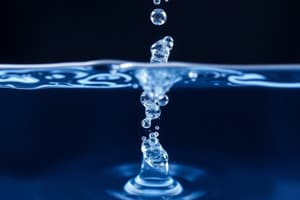Podcast
Questions and Answers
Which of the following properties of water is primarily responsible for capillary action?
Which of the following properties of water is primarily responsible for capillary action?
- High specific heat
- Density anomaly
- High heat of vaporization
- Cohesion and adhesion (correct)
Water's high specific heat allows aquatic environments to experience rapid temperature changes.
Water's high specific heat allows aquatic environments to experience rapid temperature changes.
False (B)
How many hydrogen bonds can a single water molecule form with other water molecules?
How many hydrogen bonds can a single water molecule form with other water molecules?
four
The negative logarithm of the hydrogen ion concentration in a solution is known as the ______.
The negative logarithm of the hydrogen ion concentration in a solution is known as the ______.
Match the following terms with their correct descriptions:
Match the following terms with their correct descriptions:
Why is ice less dense than liquid water?
Why is ice less dense than liquid water?
Strong acids only partially dissociate in water.
Strong acids only partially dissociate in water.
What two properties of water contribute to capillary action?
What two properties of water contribute to capillary action?
In the carbonic acid-bicarbonate buffer system ($H_2CO_3 \rightleftharpoons HCO_3^- + H^+$), what role does bicarbonate ($HCO_3^−$) play?
In the carbonic acid-bicarbonate buffer system ($H_2CO_3 \rightleftharpoons HCO_3^- + H^+$), what role does bicarbonate ($HCO_3^−$) play?
Water is an excellent solvent for ______ and ionic compounds due to its polarity.
Water is an excellent solvent for ______ and ionic compounds due to its polarity.
Flashcards
Cohesion
Cohesion
The attraction between like molecules, crucial for surface tension in water.
Adhesion
Adhesion
The attraction between unlike molecules, aiding capillary action in plants.
Specific Heat
Specific Heat
The amount of heat needed to raise a substance's temperature; high in water due to hydrogen bonds.
Heat of Vaporization
Heat of Vaporization
Signup and view all the flashcards
Density Anomaly of Water
Density Anomaly of Water
Signup and view all the flashcards
Acid
Acid
Signup and view all the flashcards
Base
Base
Signup and view all the flashcards
pH Scale
pH Scale
Signup and view all the flashcards
Buffers
Buffers
Signup and view all the flashcards
Hydrogen Bond
Hydrogen Bond
Signup and view all the flashcards
Study Notes
- Water is essential for life due to its unique properties arising from its polarity and hydrogen bonding
- Water polarity enables it to dissolve many substances, making it an excellent solvent
Water Polarity
- Water molecules consist of one oxygen atom and two hydrogen atoms (H2O)
- Oxygen is more electronegative than hydrogen, so it attracts electrons more strongly, resulting in a partial negative charge (δ-) on the oxygen and partial positive charges (δ+) on the hydrogens
- This unequal distribution of charge makes water a polar molecule
Hydrogen Bonding
- The slightly positive hydrogen atoms of one water molecule are attracted to the slightly negative oxygen atoms of another water molecule
- This attraction forms a hydrogen bond
- Each water molecule can form hydrogen bonds with up to four other water molecules
- Hydrogen bonds are relatively weak compared to covalent bonds, but their cumulative effect is significant
Properties of Water
Cohesion
- Cohesion is the attraction between like molecules
- Hydrogen bonds hold water molecules together, contributing to high cohesion
- This allows for surface tension, where water molecules at the surface resist separation
Adhesion
- Adhesion is the attraction between unlike molecules
- Water adheres to other polar molecules via hydrogen bonds
- Capillary action, where water moves up narrow tubes against gravity, results from both cohesion and adhesion
High Specific Heat
- Specific heat is the amount of heat required to raise the temperature of a substance by one degree Celsius
- Water has a high specific heat due to hydrogen bonds, which resist temperature changes by absorbing or releasing heat when they break or form
- This helps stabilize temperatures in organisms and environments
High Heat of Vaporization
- Heat of vaporization is the amount of heat required to convert a liquid to a gas
- Water has a high heat of vaporization because hydrogen bonds must be broken for water to evaporate
- Evaporative cooling occurs as water evaporates, removing heat from the surface
Density Anomaly
- Water is less dense as a solid (ice) than as a liquid
- As water cools, it becomes denser until it reaches 4°C
- Below 4°C, water molecules form a crystalline structure due to hydrogen bonding, which spaces the molecules farther apart
- Ice floats, insulating bodies of water and preventing them from freezing solid
Water as a Solvent
- Water's polarity makes it an excellent solvent for polar and ionic compounds
- Hydration shells form around ions, separating and dispersing them in water
Acids and Bases
- Acids and bases are fundamental concepts related to the concentration of hydrogen ions (H+) in a solution
- Acids increase the H+ concentration, while bases reduce it
Acids
- An acid is a substance that increases the hydrogen ion (H+) concentration in a solution
- Strong acids like hydrochloric acid (HCl) dissociate completely in water, releasing all their H+ ions
- Weak acids like acetic acid (CH3COOH) only partially dissociate, releasing fewer H+ ions
Bases
- A base is a substance that reduces the hydrogen ion (H+) concentration in a solution
- Some bases directly accept H+ ions (e.g., ammonia, NH3), while others release hydroxide ions (OH-) that combine with H+ to form water
- Strong bases like sodium hydroxide (NaOH) dissociate completely, releasing all their OH- ions
- Weak bases like ammonia (NH3) only partially accept H+ ions or release fewer OH- ions
pH Scale
- The pH scale measures the acidity or basicity of a solution
- It ranges from 0 to 14, with 7 being neutral
- pH = -log[H+], where [H+] is the hydrogen ion concentration in moles per liter
- Acidic solutions have pH values less than 7
- Basic (or alkaline) solutions have pH values greater than 7
- Each pH unit represents a tenfold difference in H+ concentration i.e., a solution with a pH of 3 has ten times more H+ ions than a solution with a pH of 4
Buffers
- Buffers are substances that minimize changes in pH by accepting or donating H+ ions when needed
- They typically consist of a weak acid and its conjugate base
- One important buffer system in biological systems is the carbonic acid-bicarbonate buffer:
- H2CO3 ⇄ HCO3- + H+
- Carbonic acid (H2CO3) can donate H+ ions, while bicarbonate (HCO3-) can accept H+ ions
Importance of pH
- pH affects biological processes, as enzymes and other biological molecules are sensitive to pH changes.
- Maintaining pH is crucial for homeostasis in living organisms
- Buffers in blood and other bodily fluids help maintain a stable pH for optimal cellular function
Studying That Suits You
Use AI to generate personalized quizzes and flashcards to suit your learning preferences.




